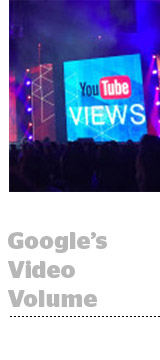 Google’s programmatic video revenues are growing fast, thanks in part to its decision to turn on exchange-based monetization of YouTube’s TrueView ad formats.
Google’s programmatic video revenues are growing fast, thanks in part to its decision to turn on exchange-based monetization of YouTube’s TrueView ad formats.
Just how fast they’re growing can be seen in figures obtained by AdExchanger as well as in data released by Google directly.
Google claims programmatic buying on YouTube via its demand-side platform, DoubleClick Bid Manager (DBM), has grown at a month-over-month rate of 55% since September 2015, when TrueView ads became available programmatically, according to a data report released Thursday. (Advertisers have been able to buy standard ads on YouTube using DBM for years.)
Expressed in real numbers, the company’s programmatic video revenue is even more impressive.
While Google has not released revenue figures, a source with knowledge of the business tells AdExchanger that for the month of November 2015, for example, US programmatic revenue was between $300 million and $400 million. Its most lucrative day ever was Super Bowl Sunday on February 7 (up to that point), when advertisers funneled about $10 million through DBM, said the source.
According to this source, YouTube represented a strong majority of inventory transacted programmatically through DBM as of Q1 2016. But that may be changing. Google reports that outside media partners have started putting more video supply up for programmatic grabs.
For example, publishers using Google’s DoubleClick for Publishers saw their programmatic video revenue grow 550% between 2014 and 2015. It should be noted that Google did not disclose a baseline figure and declined to share the volume of impressions or spend that contributed to that growth.
YouTube’s Programmatic Dawn
One of the biggest shifts in Google’s video ad business was its recent embrace of programmatic sales for its skippable, cost-per-view TrueView format.
“DBM has invested heavily in customizing an infrastructure to support TrueView, which was a big shift for programmatic buyers who were forced to completely adapt their consideration of YouTube as an inventory source, but clearly it’s beginning to pay off,” said Mike Henry, CEO of YouTube audience targeting and measurement platform OpenSlate.
OpenSlate has seen two to three times the campaign volume coming from DBM in 2016 versus 2015, Henry claims.
Google’s emphasis on selling the more premium TrueView format spurred its shift from predominantly CPM-based pre-roll video– a majority of which was served against long-tail, user-generated content – to pricing based on views and engagement.
“They had to get everybody to change their way of thinking about YouTube and start thinking on cost-per-view, which trading desks hadn’t really done yet,” Henry added. “They went through a period where they were in a trough, but then they [refocused] the market, and if you wanted to buy YouTube programmatically, you had to buy DBM.”
Part of that refocus was getting buyers to equate YouTube with television through programs like Google Preferred – which packages what Google deems the “top 5%” of video inventory on YouTube.
Google classifies Google Preferred as “programmatic direct,” claiming that between Q1 and Q4 of 2015, programmatic direct deal volume on DBM increased 39x.
Some agencies, like Interpublic Group’s MAGNA Global, have shifted sizable sums once earmarked for traditional TV to Google Preferred. MAGNA’s $250 million commitment in May was put toward newer formats like YouTube “Breakout” videos, based on the viral potential of newbie creators.
With such deals, some of a marketer or agency’s budget might be allocated to TrueView, while other YouTube formats would constitute the rest.
One month prior to enabling programmatic TrueView buys on DBM, Google had stripped third-party DSPs of their access to YouTube inventory via the DoubleClick Exchange (AdX).
It’s unclear whether the aforementioned uptick was a result of increased marketer spend – or the aftermath of its own isolationism.
Google insists only a small portion of YouTube inventory (display and non-TrueView video ads, in particular) were previously sold through AdX.
Zach Rodgers contributed.













